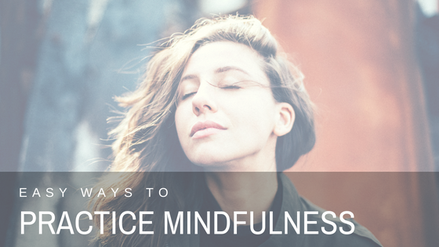|
You may have noticed everyone is talking about Mindfulness Practices. Well maybe not in those terms but you can’t drive a mile without passing a yoga studio. While yoga and meditation may be popular, they are certainly not the only type of useful mindfulness practices. Mindfulness is simply allowing yourself to be in the present moment.
Because when we think of mindfulness we automatically think about hippy yoga retreats or Buddhist meditation (or at least that’s what I use to picture), it's easy to say mindfulness practices are not for me. Most of my professional career I have worked with people in a state of crisis, like the aggressive, angry, throwing chairs kind of crisis. So when I would read articles about the benefits of mindfulness, I would easily dismiss them and think “yeah right, I’m going to tell my aggressive client to be in the moment and think about their breath!” Sounds like a good way to get hit by a chair! But what I didn’t realize was I was already doing it. I became really good and connecting and communicating with individuals in crisis because I stayed extremely calm and focused on their immediate physical and emotional needs. Kind of sounds like bringing them into the present doesn't it! The beauty of mindfulness is that it does not need to be hard or take longer than a few minutes a day. It can involve things you are already doing like going for a walk or drinking a cup of coffee. But rather then doing these activities and letting your mind stress about your day’s to do list, you actively focus your mind on the present. Why Mindfulness? We can all agree we live in a fast paced world that is constantly bombarding us with stress. Not to get too technical, but when we are faced with stress, our brains respond very differently then when operating in a calm state. Stress triggers a part of our brain, called the amygdala, to respond and activate our Fight-Flight-Freeze response. This response literally turns off the part of our brain used for rational thinking. That is why when we are highly stressed, we act irrationally. When this area of the brain is activated frequently, it can have negative effects on not only our actions but on our health. Practicing mindfulness daily, even for just a few minutes can retrain your brain to turn off or slow down the activation of the amygdala and stress response, keeping you in a calm, thinking state even when confronted by a stressful event. So when and where should I practice Mindfulness? Easy answer, literally anytime, anywhere! Life is busy, so even if you start your lunch break at work with five minutes of a mindfulness practice, you will get the benefits from it. If you have children, I highly recommended practicing it with them. By encouraging mindfulness, you will help them learn appropriate coping skills and can always pull out those calming reminders when they start to get upset. So here are a few simple ideas to start introducing mindfulness into your life today.
Try an easy mindfulness activity for a few days and see how you feel. Not only will mindfulness help your emotional regulation and decrease overall stress levels, it will benefit your physical health in the long run.
0 Comments
Your comment will be posted after it is approved.
Leave a Reply. |
AuthorAmanda Be, LMSW, MBA is owner and counselor at Supportive Counseling Services in Grosse Pointe, MI. Amanda has been a practicing clinical social worker since 2005. She is passionate about helping others lead happier, more successful lives through her private practice, advocacy and volunteer work. Amanda’s main objective is to support others during life’s challenges and hopes these blogs will help. She writes and speaks on topics for parents, counselors and educators. Archives
March 2020
Categories
All
|

 RSS Feed
RSS Feed